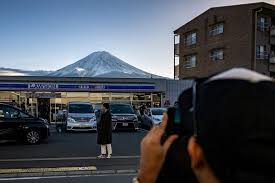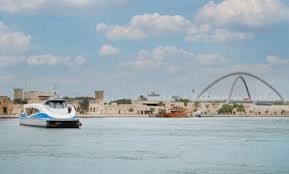
Anna Kaminski
Our tiny Cessna juddered above the tundra – a landscape of vivid green threaded with dark blue streaks of meltwater streams and blotched with myriad ice-melt lakes. In places, the land bubbled up in smooth green hillocks. “Pingos,” the pilot’s voice came through my headphones. “Permafrost hillocks,” he explained, seeing my raised eyebrows. A dark ribbon of road wound its way between these strange, rounded protrusions. A couple of days prior, I’d driven the Dempster Highway all the way to the Arctic Ocean and wanted to see it from above before making my long journey back to Dawson City, Yukon.
The Dempster is considered to be one of Canada’s toughest drives. “Highway” is a rather glamorous term for a lonely gravel road that branches off the Klondike Highway – which runs between Yukon’s capital, Whitehorse, and the Klondike Gold Rush settlement of Dawson City – cutting its way through 764km of dense spruce forest, tundra and snow-covered hills before arriving in Inuvik, the northernmost Arctic town in the Northwest Territories.
The Dempster Highway was conceived in the late 1950s to open up the MacKenzie Delta to oil and gas exploration and traced a decades-old dog sled patrol route. Now, a new stretch of highway connects to the Dempster, extending a further 147km beyond Inuvik, all the way to the tiny settlement of Tuktoyaktuk on the shores of the Arctic Ocean.
This long, lonely Dempster Highway is one of Canada’s ultimate road trips; an exhilarating four-wheeled adventure across a pristine northern landscape. It’s also a hard drive in a hard land (you get a certificate of completion from the Inuvik tourist office if you drive its entire length) as the road is unpaved, there’s no phone signal and there’s only one petrol station around halfway along. Anyone who drives it needs to be prepared for misadventure, as I found out myself.

The 764km Dempster Highway winds its way through mountain ranges and crosses mighty rivers (Credit: Pierre Longnus/Getty Images)
Our little group – me, the pilot, a couple more sightseers – was returning to Inuvik after a day trip to Tuk (as locals call Tuktoyaktuk), run by Tundra North Tours. Until 2018, the Inuvialiut (Western Canadian Inuit) hamlet could only be accessed via bush plane, boat or ice road in winter, and Tuk’s inhabitants still live mostly off the land: fishing, hunting and trapping, storing caught game in the community freezer underground. Some, like local guide Eileen Jacobson, who welcomed us into her home to try on her fur parkas and to sample pipsi (dried Arctic char) – an Inuit staple – were both hopeful and apprehensive about the permanent impact the new road will have on their lives.
“Maybe it’ll bring more visitors,” she said. “And maybe the price of gas, of groceries, will go down.”
But there were undercurrents of concern as well. Locals up here are all too aware of how other, more accessible Inuit and First Nations communities in Canada have been devastated by the twin scourges of drugs and alcohol. Also, while Canada’s Inuit receive government support for their traditional ways of life, age-old skills are nevertheless dying out, as dependence on modern technology replaces age-old navigation and hunting skills.
I was still pondering all this a couple of days later as I was leaving Inuvik and its igloo church, rows of pastel-coloured houses and Alestine’s, where I’d been going every day for bowls of reindeer chilli and fish tacos cooked inside an old school bus covered with sassy bumper stickers.
At first, things went well. I navigated the bumpy washboard section of the Dempster in my SUV, hemmed in by dwarf spruce forest, and made it to the banks of the mighty MacKenzie River in just more than two hours. The waiting car ferry promptly whisked me across, past the blink-and-you’ll-miss-it Gwich’in settlement of Tsiigehtchi sitting across the tributary from the ferry landing.

The route traverses the Arctic Circle, now going all the way to Tuktoyaktuk on the shores of the Arctic Ocean (Credit: Istvan Hernadi photography/Getty Images)
A little while later, I was turned away from the Peel River ferry landing, south of the marginally larger Gwich’in settlement of Fort McPherson – the last town I’d see before Dawson City, some 580km south. I was told that the summer meltwater had raised the water levels in the river and this ferry could not dock. “When will service resume?” I asked. The man shrugged. “Maybe tomorrow, maybe not.”
Like the locals, I’d found myself at the mercy of nature’s caprices. Unlike the locals, however, it was not a matter of life or death for me. Imagine having a medical emergency in Fort McPherson during the freezing (November to December) or the thawing (March to April) of the two rivers, when ferries aren’t running but the ice road isn’t open either.
I spent the night at the Peel River Inn, the settlement’s only motel, returning to the car ferry landing the following day. By this point, I was racing against time. Having used up one of my two “just-in-case” reserve days, I had little room for error if I wanted to make my flight out of Whitehorse. This time, I was in luck. The summer meltwater had receded sufficiently for the car ferry to dock, and I gingerly drove my SUV onboard.
Dense evergreen forest hugged the road on both sides and gravel flew from beneath my wheels as I pressed on south. There was a meditative quality to the monotony of the landscape; within hours, I’d left the craggy hills, snow-flecked tundra and glacial rivers behind and the world outside my car had been reduced to a green blur of spruce.
“I should make my flight as long as I don’t break down again,” I thought to myself. But besides the hassle of having to rearrange my travel plans, there was a more compelling reason I didn’t want to be stranded in these parts. It was not hunger or thirst that worried me, and by now I was even relatively phlegmatic about potential grizzly bear encounters. But I was frightened of wildfires, which have become increasingly common in the Canadian Arctic in the summer, caused by lightning storms. Having had to drive through the smoke of a wildfire elsewhere in the Northwest Territories, I discovered that the smell of burning triggered visceral, primal fear.

The remote landscape is home to a variety of wildlife, including grizzly bears (Credit: milehightraveler/Getty Images)
Luckily, along the Dempster that day, the weather obliged and the forest around me remained reassuringly damp and fog shrouded. It began to rain. Relief gave way to anxiety as the spatter of raindrops on my windshield became a deluge. Before long, the car skidded sideways as gravel-and-dirt turned to mud, and I discovered that there’s little advantage to driving a 4X4 when you’re trying to keep the car straight and steady and away from the sloping sides of the road. To skid off the side would be a disaster.
So when the Eagle Plains motel – the halfway point along the Dempster – came into view, I was so relieved that I began to shake.
There’s no phone signal along the Dempster for the most part, and hardly anyone’s got a satellite phone
“It’s happened a couple of times,” the waitress at the motel’s restaurant confirmed, glancing around the largely empty dining room, when I recounted what happened to me. She was happy to shoot the breeze while I ordered from the menu of burgers and meatloaf. “The driver went too fast on mud and slid right off the side. It’s like driving on ice.” I nodded. “Couldn’t even call us,” she continued. “There’s no phone signal along the Dempster for the most part, and hardly anyone’s got a satellite phone. Had to catch a ride back here with the next car they saw and wait a couple of days here before their car could be hauled out of the ditch.”
I told her that the Dempster almost got me on the first day, when I originally drove up to Inuvik. After navigating some 360km – the first half of the drive – without incident, I was lulled into a false sense of security. “I wonder why my guidebook insisted on not one but two spare tyres,” I thought idly to myself. Before long, my car started beeping, snapping me out of my reverie. On the console, I could see the pressure in one of my back tyres dropping alarmingly. A puncture.
Flat tyres are less common than they used to be, back in the days when the Dempster was covered in tyre-shredding shale rather than more benign gravel, but it was a timely reminder that a mishap can still happen at any time. I had a jack and wrench and could change a tyre, in theory. But in the end, I managed to coast the last few kilometres into Eagle Plains on a near-flat, straight into the care of the resident mechanics, who patched my car up, enabling me to reach Inuvik the same day.

The Dempster is considered to be one of Canada’s toughest drives (Credit: Pierre Longnus/Getty Images)
Now, on my way back to Dawson City, the last half of the drive back to the Klondike Highway was smoother sailing, with the forest opening up, the sun shining, the road arrow straight. But then, as a crowning touch, just as I passed the Dempster-Klondike junction, I got a strong whiff of petrol. I watched in disbelief as my fuel tank emptied within seconds, and the car came to a halt as the engine died – yet another reminder of the obstacles that the Dempster may throw at you.
There was no phone signal, and as I stood on the Klondike Highway some 40km east of Dawson City, my car abandoned, it was possible that potential rescuers would not drive by for hours. However, within minutes of my breaking down, a Good Samaritan picked me up. As he drove me to my guesthouse in Dawson City, I realised that this had been part of the Dempster’s charm all along: that whenever I’d come close to disaster, fortune smiled on me.
Perhaps Canada’s toughest road wasn’t so tough after all.
Courtesy: BBC
The post Driving Canada’s toughest road appeared first on The Frontier Post.








